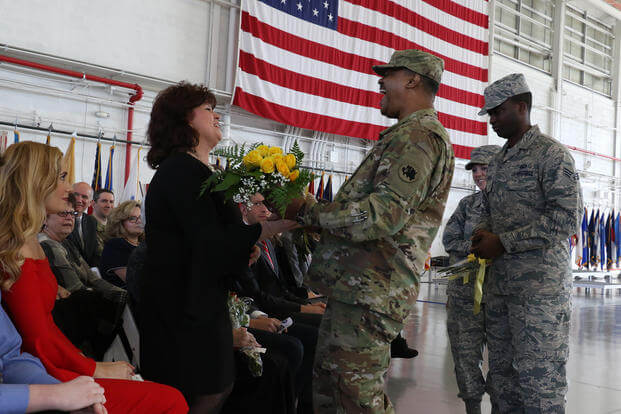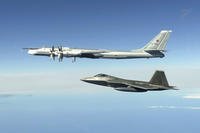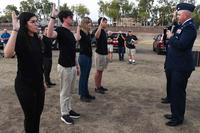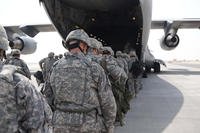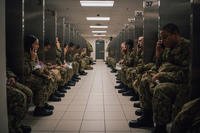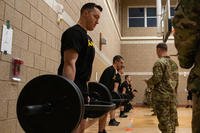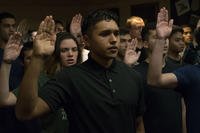What Are the Reserves and National Guard?
The Reserve components of the Armed Forces are: The Army National Guard of the United States, the Army Reserve, the Navy Reserve, the Marine Corps Reserve, the Air National Guard of the United States, the Air Force Reserve and the Coast Guard Reserve.
All Reserve and Guard service members are assigned to one of three Reserve component categories -- the Ready Reserve, the Retired Reserve and the Selected Reserve.
What Are the Qualifications to Join the Reserves and National Guard?
The following are the basic requirements for joining. You must:
- Be a U.S. citizen or nationalized to be a Reserve or National Guard officer.
- To enlist, you must be a U.S. citizen or a resident alien.
- Age requirements differ between branches of service, but in general, you must be between the ages of 17-35 with no prior service (NPS). The Guard experimented with raising the age to 42 but reverted to the lower age in 2011. Note: Seventeen-year-olds need parental consent. Or between the ages of 17 and 59 for those with prior service (PS) and are able to complete 20 years of creditable service for retirement by age 60.
- Take and pass the Armed Services Vocational Aptitude Battery (ASVAB) test.
- Pass an Armed Forces physical examination.
- Must be available for initial active duty training.
- Must agree to participate in an initial tour of active duty training of at least 12 weeks.
Types of Status in the Reserve and National Guard
All Reserve and Guard service members are assigned to one of three Reserve component categories -- the Ready Reserve, the Standby Reserve and the Retired Reserve.
The Ready Reserve
There are three categories of the Ready Reserve: Inactive National Guard, Individual Ready Reserve and Selected Reserve.
Inactive National Guard
This is a status used only by the Army National Guard. If you leave a drilling National Guard unit before the end of your enlistment, you will be placed in the Inactive National Guard, unless you specifically request to be placed in the Individual Ready Reserve (see below). In this category, you cannot drill for pay or retirement points. Likewise, you cannot take part in any annual training or be promoted.
Though you are considered "inactive," you still are required to present yourself, or "muster," with your last unit once a year. Also, in the event of a full-scale mobilization, you could be recalled to service with that unit.
Individual Ready Reserve
If you enter the Reserves or Guard through the delayed entry program, this is most likely the category you will fall in while awaiting basic training. If you have an enlistment that runs out after four years, you also may find yourself classified as Individual Ready Reserve, or IRR, in order to complete six years of total service. In the IRR, though it is not required, you still can be promoted, compile retirement points and participate in annual training.
You are not affiliated with any drilling unit in the IRR, so it is up to you to complete any correspondence courses that may be required by your military occupational specialty (MOS) for drill points. Also, it will be up to you to find a command that has funding to send you to annual training if you want to keep accruing retirement points. Postings for annual training slots open to IRR members usually can be found on the branch website or by contacting your personnel officer.
Selected Reserve
Active Guard and Reserve (AGR)
The AGR is made up of reservists who serve on active duty to keep their units functioning on a day-to-day basis in training or administrative roles. There are other AGR members who serve as recruiters or instructors. The AGR category is very broad and encompasses not only active Air Force Reserve, Army Reserve and National Guard, but also the Navy Full Time Support (FTS) Officer Program, and Marine Corps Active Reservists.
As a member of the AGR, you are assigned a full-time mobilization slot or billet in the unit you serve in on that one weekend a month/two weeks a year. This affords the opportunity to continue a military career but not have to move as often as those in the active duty.
If you want to follow this path in the Navy, then you will be required to pull some sea duty as part of the FTS program, but when you are ashore, you will be assigned to administer a reserve unit.
Individual Mobilization Augmentees (IMA)
As part of the IMA, you will be assigned to an active-duty unit. So in a time of war or national emergency, you could be called up quickly to bring your unit up to strength.
You will be required to train with your active-duty unit for two weeks a year. However, in addition to annual training, you will be required to earn 40 extra "drill" points per year for retirement. These points can be earned through working at your unit "for points only" (meaning you will not get paid) or by taking correspondence courses.
All of the services have IMAs in a variety of ranks and skills, and the Navy mainly uses the category for senior officer levels.
Selected Reserve Units
This is what most people think of when they think of the "weekend warrior.'' As a reservist or guardsman, you likely will fall into this category. This is where you will serve "one weekend a month, two weeks a year.'' You will be required to complete 40 unit training assemblies or "drills," and two weeks of annual training.
For the most part, drills are held once a month on weekends. During your drill, you will be paid for four days of work, five if the drill weekend starts on a Friday.
Some things to consider before you join a unit is to ask about the unit's drill schedule to make sure you can work your civilian job around it. Also be aware, with the downsized military, the Guard and Reserve are contributing more to the duties that once were performed by active-duty units. So be prepared to deploy.
Also, if you are in a job that directly supports an active-duty unit, your drills may not fall into the "one weekend a month" category. Positions in these units drill whenever they are able, sometimes even during the week. This can be a benefit if your civilian job has irregular hours.
Military Technicians
These are full-time federal civilian employees who are also reservists. They are also known as "dual-status" and perform the administrative and training duties for the reserve units they serve. What makes them different from AGR personnel is that they do not qualify for active-duty military pensions. They receive federal employee and retirement benefits and qualify for reserve military pensions.
Retired Reserve
Though this area may not seem pertinent to you as you enter the Reserve or Guard, we will throw it in anyway as something to aim for while you are in the "front leaning rest" position at boot camp. After all, it's never too early to start planning your retirement.
Following a career in active or reserve duty, individuals are placed in what is known as the Retired Reserve while they continue to collect their military pensions and benefits.
Also in this area are "gray area reservists," who are reservists who are eligible for retired pay but have not reached their 60th birthday, to enable them to begin collecting their military pension.
To reach the status of Retired Reserve, you must be an active-duty enlisted retiree of the Army or Air Force with more than 20, but less than 30, years of combined active and inactive service. Once you hit 30 years, you are fully retired. If you are a retired enlisted member of the Navy or Marine Corps with 20, but not 30, years in, you are moved into what is called the Fleet Reserve or Fleet Marine Reserve.
So after you've had an exciting and fulfilling career in the service of your country and have reached the 30-year mark, in addition to having an endless supply of stories to impress your family and friends, you will be assigned to one of three categories in the Retired Reserve. These categories depend on your age, physical fitness and date of retirement from service.
If you are not yet 60 years old or disabled, you will be placed in Categories 1 or 2. Which category you are assigned to will depend on your physical condition and how critical your skill is. Here you still are considered eligible to be mobilized in the event of a national emergency or war.
If you are a disabled veteran or over 60 years old, you are still not free from being called back to the colors. However in Category 3, your case is evaluated on an individual basis.
Standby Reserve
The Standby Reserve are reservists or members of the Guard who maintain their military affiliation but are not members of the Ready Reserve.
Normally these reservists are key federal employees, such as senators, congressmen and senior agency officials. They also can be civilians in the defense industry whose employers designate them as crucial to national security.
This status allows them to maintain their rank and standing in the reserves while serving the government in other ways.
Active Status
These reservists voluntarily can participate in training for retirement but receive no pay. They are eligible for promotion, with the exception of promotion to the flag or general officer level.
Inactive Status
These reservists are not authorized to participate in training for retirement points and cannot be promoted. Those who elect to be transferred to this status because of hardship or health reasons are allowed to maintain their military status, because they have skills the Reserve might need in the future.
It takes an act of Congress to get the Standby Reserve recalled to active duty, and then only when there are not enough Ready Reservists to do the job.
What's the ASVAB?
The ASVAB is a test that measures your aptitudes. It consists of 10 short individual tests covering word knowledge, paragraph comprehension, arithmetic reasoning, mathematics knowledge, general science, auto and shop information, mechanical comprehension, electronics information, numerical operations and coding speed. When you take the ASVAB before enlisting, not only do you receive scores on each of these individual tests, but several individual test results are combined to yield three academic composite scores: verbal, math and academic ability.
What Are Some Benefits of Joining?
- Steady income: You are paid twice a month, on the first and 15th, every month, based on your pay grade and service requirements.
- Advancement: You are promoted based on job knowledge, your performance, time in pay grade and service requirements.
- Paid vacation: You earn 2.5 days of paid vacation per month for a total of 30 days each year, up to 60 days.
- Training: You choose your career path based on your aptitude, physical abilities, security clearance, motivation and determination.
- Health care: While on active duty, you will receive complete medical and dental care at no cost.
- Life insurance: While serving on active duty (for instance, during boot camp and annual training) members can select inexpensive term life insurance.
- Allowances: While serving on active duty, you will receive additional tax-free money for Basic Allowance for Subsistence (BAS), if government food facilities are not available in the area you are stationed; and a uniform allowance (for enlisted personnel only) to help maintain your uniform.
- Tax advantage: Only your basic monthly pay is subject to federal or state income tax.
- GI Bill: The Montgomery GI Bill will help pay for college education or vocational training.
- Tuition assistance: While in the Reserves or Guard, you may continue your education and may be helped in defraying the cost of college-accredited courses. Additionally, if you are in the National Guard, some states offer substantial benefits such as free tuition to state colleges or universities. To find out more on this bonus, talk to your recruiter or education officer.
- Additional benefits: There are exchange and commissary privileges, temporary lodging expenses, travel, Veterans Affairs home loans and more.
Do I Have to Join Another Branch of Service First?
No. You do not have to join another service before joining the Reserve or National Guard.
Do the Reserve and National Guard Take People with Prior Service?
Yes. The Reserve and National Guard accept people with prior service.
What if I Am not a US Citizen?
Only U.S. citizens or foreign nationals legally residing in the United States with an Immigration and Naturalization Service Alien Registration Card (or "green card" -- INS Form I-151/551) may apply. Applicants must speak, write and read English fluently.
Can the Reserve and National Guard Help Me Obtain US Citizenship?
No. The U.S. military cannot assist foreign nationals in obtaining admittance into the United States.
What if I Live Overseas?
Regulations prohibit the forwarding of recruiting information through international mail, even to U.S. citizens living in foreign countries. Use our online form to reach a recruiter electronically.
How Long Is Boot Camp?
Basic training, or boot camp, lasts from 8-13 weeks, depending on the branch. After you have finished boot camp, you will be sent to advanced individual training, or AIT, where you will receive in-depth training in your military occupational specialty (MOS) or rating.
Should I Do Anything Before I Go to Boot Camp?
Yes. Prepare yourself for running and physical fitness training, and lots of it.
How Do I Become an Officer?
The Reserve or National Guard seeks commissioned officers through several different sources. You must 18 or older (maximum age requirements vary from service to service), be of good moral character and meet academic, physical, medical and security requirements.
What Is the Simultaneous Membership Program (SMP)?
The simultaneous membership program (SMP) is a unique program offered by the Reserve and National Guard. It allows a college-bound member of the Reserve or National Guard who is already assigned or has enlisted in an Army National Guard (ARNG) unit to enroll simultaneously in an Reserve Officer Training Corps (ROTC) program. SMPs enter the Army's Advanced ROTC program while at the same time serving in their unit as a cadet.
This on-the-job training was designed to relieve a shortage of junior officers in the Army National Guard. If you participate in the SMP, you continue to serve and draw monthly and annual training pay while you are in the ROTC. Additionally, Army ROTC cadets receive a $200 monthly stipend.
An SMP cadet performs the duties of a second lieutenant under the supervision of a commissioned officer. The requirements for this program are that you must be 30 years of age or younger, attend college full time (usually about 12 semester hours at most colleges) and be in good physical shape.
The SMP is offered only on campuses where an Army ROTC program exists -- or if you participate in an Army ROTC program at a nearby college or university. If you try SMP, you still will attend ROTC Advance Camp during the summer between your junior and senior year.
How Do I Apply for OCS?
If you have a four-year college degree from an accredited college and meet all age, physical and moral requirements, you may apply for OCS. The application process includes scoring well on the ASVAB and passing your physical. Your SAT or ACT scores also will be needed. Upon completion of your officer package, you will have an interview with a board of your superior officers. The completed package will be submitted to a second board, which will select the top candidates from the packages they receive.
What About Direct Commissions?
As a professional lawyer, doctor, dentist, nurse or health-care professional, you also may qualify for a direct commission into the Reserve or National Guard.
Are There Promotions to Officer Rank from Within the Reserve and National Guard Enlisted Ranks?
Yes. Enlisted members may compete for OCS slots if they have four years of service, obtained the rank of E-5 or above and have at least 30 college credits. Enlisted members of the Reserve and Guard also may apply for acceptance into the warrant officer program.
What Is a Warrant Officer?
Warrant officers are found in the Army, Army Reserve and Army National Guard. The definition is an officer appointed by warrant by the secretary of the Army, based on a sound level of technical and tactical competence. The warrant officer is the highly specialized expert and trainer who, by gaining progressive levels of expertise and leadership, operates, maintains, administers and manages the Army's equipment, support activities or technical systems for an entire career.
The warrant officer option is open if you currently are ranked an E-5 or higher in the Army National Guard (ARNG), a soldier in the Army Reserve or if you are transitioning into the Guard or Reserve from active duty.
You are eligible for the warrant officer program if you:
- Are between the ages of 18 and 46
- Score 110 or above on the General Aptitude Area Test
- Are a high school graduate or pass the General Educational Development test (GED)
- Are a U.S. citizen by birth or naturalization
- Successfully pass all events on the Army physical fitness test
- Meet certain mandatory technical qualifications for your specific MOS
- Meet certain medical, security and licensing requirements (depending on your specific MOS)
If you are applying to the warrant officer program to be a rotary wing aviator, you must not be older than 27 years, 6 months at time of application.
To be commissioned as a warrant officer, it is necessary to complete the Warrant Officer Candidate School (WOCS).
As a member of the Guard or Reserve, you have two options for completing this training:
- A six-week active Army resident school at Fort Rucker, Alabama.
- Two two-week phases of WOCS-RC (Reserve Component) at Fort Rucker.
These phases may be taken back to back or separately.
After completing the Warrant Officer Candidate School (WOCS), you have two years to complete the warrant officer basic course (WOBC). This is further training in your MOS and makes sure that you effectively can perform the required duties in your chosen field.
Again, you will have the option of attending the active component or reserve component WOBC. Depending on your MOS, the length of the active component WOBCs is from 5-20 weeks. In many cases, the WOBC-RC course is a correspondence phase and one or two weeks of active duty for training (residence phase).
What if I'm a Physician or Dentist?
The Reserve and National Guard also is seeking qualified health professionals. For more information about medical programs, you can have someone contact you about applying your medical trade in the Reserve and National Guard by completing this form.
What if I Have a Problem Getting Time Off from My Employer to Fulfill My Military Service Obligations?
By law, as a member of the Reserve or National Guard, you must, upon request, be granted a leave of absence to satisfy a requirement for military training. The Uniform Services Employment and Reemployment Rights Act requires employers to provide Reservists with time away from their jobs to perform military duty. However, you must notify your employer that you intend to take military leave. You must be reemployed after completion of your military duty and return to your job within a reasonable time. You must be treated as though you never had left employment, including schedule pay raises, promotions or credit for longevity or vacation. Your employer only has to hold a job open for 60 months if you accept voluntary orders.
How Do I Become a Pilot in the Reserve or National Guard?
The Air National Guard also offers flight training. Candidates first undergo the pilot candidate selection method (PCSM). You will take the Basic Attributes Test (BAT) with the Air Force Officer Qualifying Test (AFOQT). Any private flying time is taken into consideration. As of January 2000, all candidates are required to have a private pilot's license. If you do not have one, the good news is that, if you qualify, the Air Force will fund flying training in your local area, with an Air Force-approved flying training instructor.
The next step would be to attend the Air National Guard Academy of Military Science at McGhee Tyson Air National Guard Base (ANGB) in Knoxville, Tennessee, for a six-week commissioning program. As a new second lieutenant, all pilot candidates attend specialized undergraduate pilot training (SUPT) for 52 weeks. After graduation, pilots attend training for the aircraft they will be flying in their Air National Guard unit; this lasts from 8-20 weeks.
How Do I Choose My Military Occupational Specialty (MOS)?
You can request any MOS for which you qualify. The results of your ASVAB determine what specialties you are eligible to request. Some of the more popular areas may have a waiting list; when speaking to a recruiter, be sure to inquire if there is a wait. Be aware that some waiting periods for certain MOSs range from a few months to more than two years. You must have a minimum of 30 months remaining on your enlistment before you can enter any school for an additional MOS. If the school you want has a very lengthy wait, you may need to extend your enlistment a number of months to bring the total left on your enlistment to 30 months.
Is Advanced Individual Training (AIT) like Boot Camp?
No. This is training for the specialty (MOS) you have chosen. It may involve work details and duty, but the main focus is on technical and professional training.
Will I Be Paid While at Advanced Individual Training?
Yes, you will be paid for every day you drill or on active duty while in the Reserves or National Guard. You will receive pay according to published pay schedules for your pay grade, in addition to any Temporary Duty (TDY) or travel allowances.
What Should I Ask My Recruiter?
Recruiters must present an accurate picture of training in the Reserves or National Guard. You should be aware of all aspects of the environment in the Reserves or National Guard. Be sure you fully understand the enlistment contract. You should ask about:
- Details and qualifications for each specialty.
- Films or videos about training and duties.
- Boot camp (There are videos available to show you what basic training encompasses.)
- Length and location of training.
- Special enlistment programs if you have completed Junior ROTC.
- Overseas deployments, remote and long duty.
- Haircut and grooming standards.
- Off-duty education and educational benefits.
- Guaranteed training programs.
Where Do I Get More Information?
We can put you in touch with recruiters from the different military branches. Learn about the benefits of serving your country, paying for school, military career paths, and more: sign up now and hear from a recruiter near you.
Want to Learn More About Military Life?
Whether you're thinking of joining the military, looking for fitness and basic training tips, or keeping up with military life and benefits, Military.com has you covered. Subscribe to Military.com to have military news, updates and resources delivered directly to your inbox.
